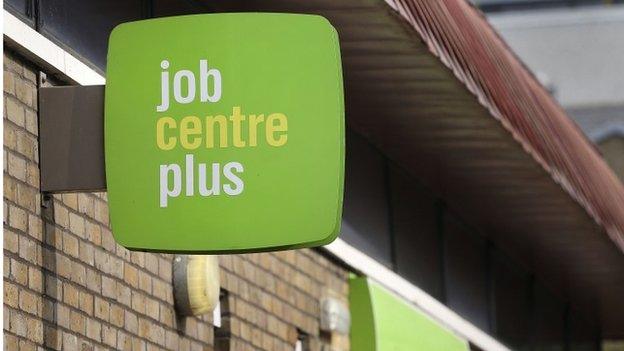UK productivity remains subdued
- Published

UK productivity remains subdued despite stronger economic growth, official figures show.
The Office for National Statistics (ONS), external said output per hour rose by 0.3% in the first three months of the year compared with the previous quarter.
It added this measure or productivity had grown by 1.3% in the year to the end of March, the fastest rate of growth since the start of 2012.
But productivity across the whole economy fell slightly, it added.
On Tuesday, the ONS revised UK economic growth up 0.5 percentage points for the year to the end of March to 2.9% and said the economy grew by 0.4% in the first three months of this year.
Official figures last month showed unemployment in the UK had fallen to 1.81 million and average wages rose at their fastest rate in four years.
The ONS tends to focus on output per hour as its main measure of productivity, claiming it is a more comprehensive way of measuring output..
It also looks at unit labour costs - the cost to companies of employing staff - as well as the number of available jobs, workers and hours worked.
Output per hour expresses the amount produced by a company after all its costs have been stripped out. The more efficient, or productive, the company, the greater its level of output per hour.
But the ONS said output per hour remained 1% lower on average in the first quarter of 2015 compared with the same period in 2008.
It said productivity remained "exceptionally weak" across many industries.
Output per hour in services - other than financial services - has grown by about 0.2% per quarter since the first three months of 2009, compared with 0.5% per quarter before the economic downturn.
Productivity puzzle
Output per hour in manufacturing has expanded at an average quarterly rate of around 0.3% since the start of 2009, compared with almost 1% per quarter before that.
The Bank of England has consistently referred to the UK's productivity problem and it is a key concern for the Bank's Monetary Policy Committee - alongside inflation - in determining when to raise interest rates.
Howard Archer, chief UK and European economist at IHS Global Insight, said if productivity had taken a significant lasting hit, it meant the economy had less "spare capacity" to grow without generating inflationary pressures and that interest rates would need to rise at an earlier stage.
Spare capacity is the Bank of England's measure of the extent to which the UK economy is underperforming, as a result of a lack of business investment either in hiring new staff, technology or machinery. It has become one of the key measures that will determine when interest rates begin to rise.
Mr Archer said one argument for continued low productivity was that employment levels largely held up throughout the financial crisis, with companies often switching staff to part-time roles, implementing pay freezes or reducing hours worked per member of staff.
He added: "If much of the weakness of productivity is cyclical, then it clearly should improve markedly as the economy sees sustained decent growth. The more that productivity improves, the greater the scope of the Bank of England to keep monetary policy very accommodative.
Manufacturing slowdown
"However, if productivity fails to pick up appreciably over the coming quarters, it indicates that the economy has less potential to grow without generating inflationary pressures and that interest rates will likely need to rise at a faster rate than would otherwise be the case."
At the same time, the Markit/CIPS Purchasing Managers' Index, external indicated growth in the UK's manufacturing sector slowed to its lowest pace in more than two years in June.
The closely watched index fell to 51.4 from 51.9 a month earlier.
Any reading above 50 indicates growth, while below 50 points to contraction. But Markit said the manufacturing sector was undoubtedly seeing a slowdown in growth, with production output expanding at its slowest pace since April 2013.
"The UK manufacturing sector had a disappointing second quarter overall," said Rob Dobson, economist at Markit.
"Growth trends in output and new orders were the weakest since the opening quarter of 2013, as a strong sterling exchange rate and subdued demand from mainland Europe offset the continued solidity of the domestic market."
- Published1 July 2015

- Published30 June 2015

- Published17 June 2015

- Published12 June 2015
